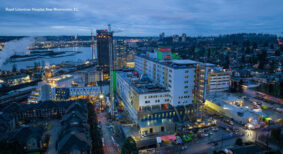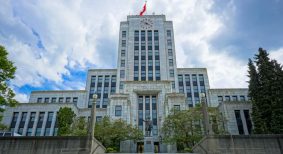Langara College in Vancouver has officially opened its new Science and Technology Building. The ribbon-cutting event included Advanced Education Minister Andrew Wilkinson, Vancouver Deputy Mayor Heather Deal, Chief Wayne Sparrow of the Musqueam First Nation, and Langara students, board members, faculty, and staff.
“This new facility provides new spaces and opportunities to enhance our students’ learning. Our entire community is so excited about this beautiful signature addition to our campus,” said Dr. Lane Trotter, president, Langara College.
The state-of-art building will meet the growing demand for science and technology education. Adding more than 1,000 square metres of student space and 35 new laboratories and classrooms, the five-storey building is the new home for several programs including computer science, biology, physics, internet and web technology, nursing, and more. On the west side, a dramatic 16-metre cantilevered portion incorporates a skylight window that allows natural daylight to penetrate through to the ground below.
“Collaboration between the sciences is key. The pristine cantilevered volume of labs is disturbed by the vortex lounge which spirals up through the building around a glowing oculus, mixing students from all disciplines together in a dynamic social space,” described Stephen Teeple, technical and design Architect, Teeple Architects.
Principle architects on the project were Teeple and Kori Chan, Proscenium Architects. Construction of the new building began in April 2014, led by Bird Construction.
Advancing the College’s sustainability goals, the project is targeted for a Leadership in Energy & Environmental Design Gold designation by using highly-efficient building systems and fully integrating healthy living components.
LEED design features include energy efficient building envelope; low-flow fume hoods with adjustable sashes; and, energy-efficient mechanical and electrical systems.
The employed energy efficient strategies and systems have resulted in an overall annual energy cost savings of 45 per cent (over $74,000 in utility cost savings) compared to a conventionally constructed building.









